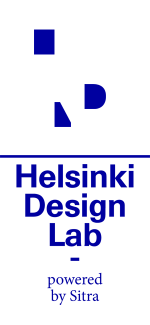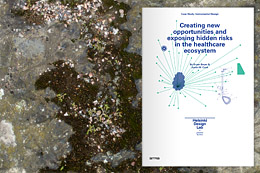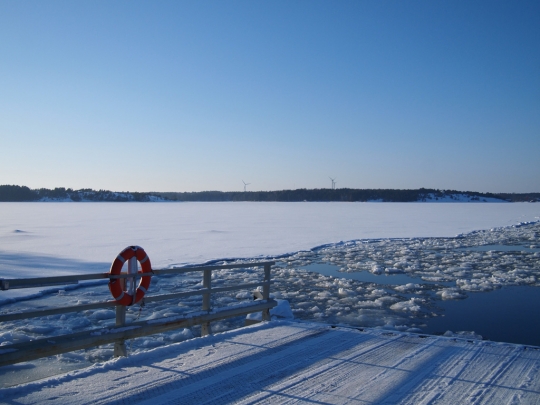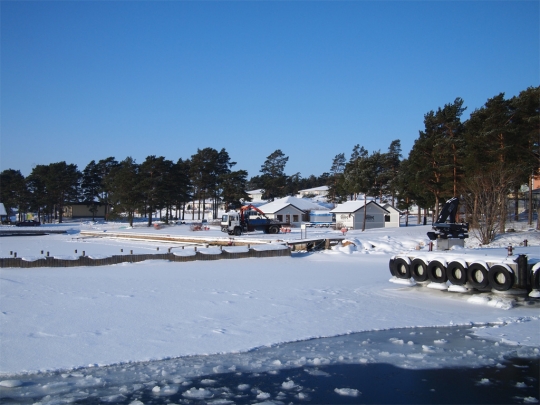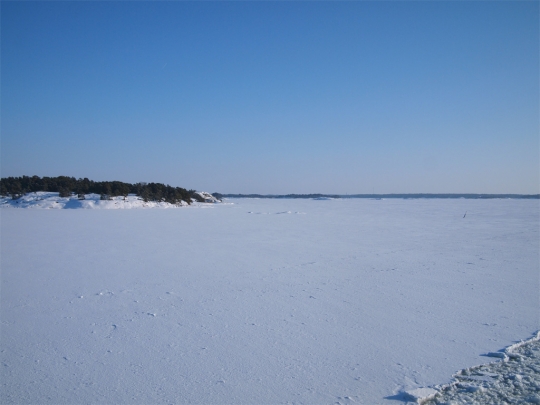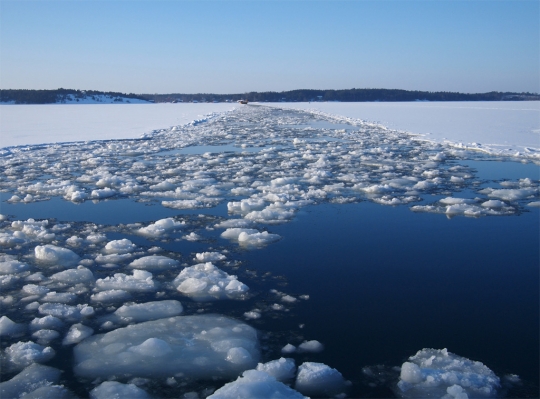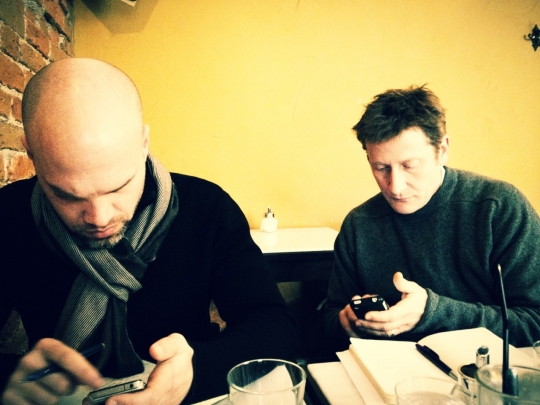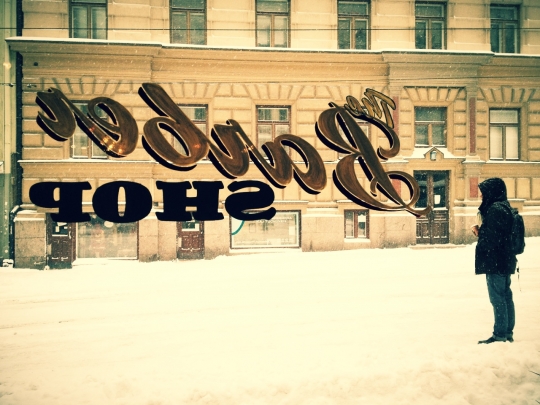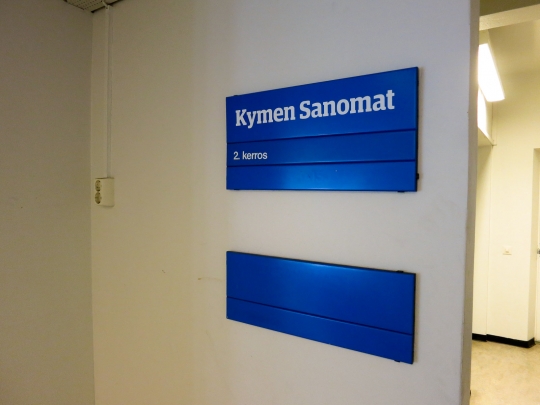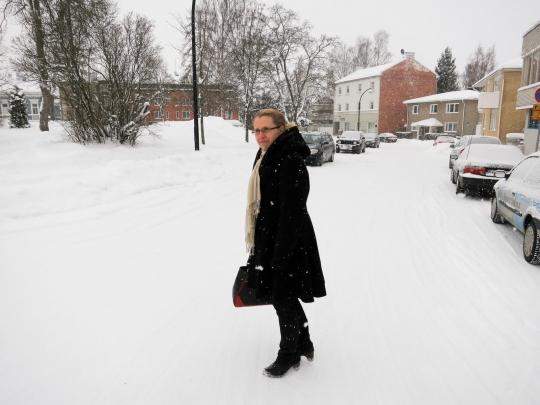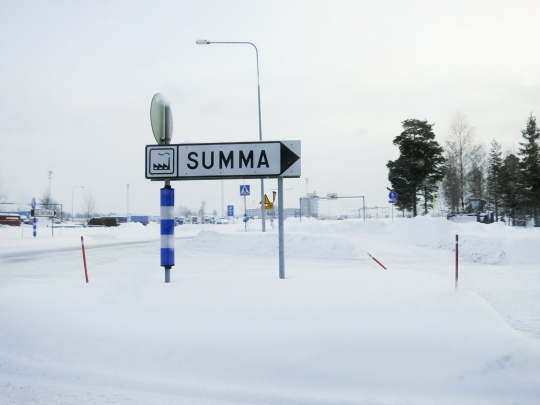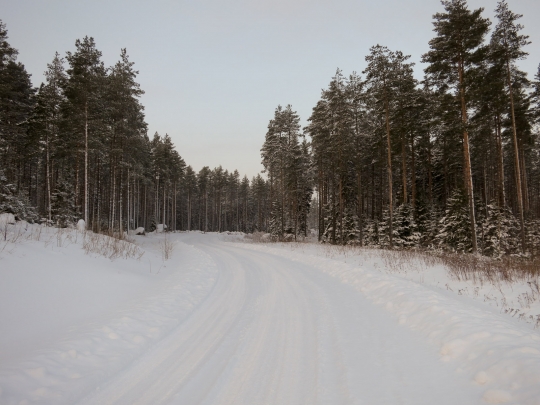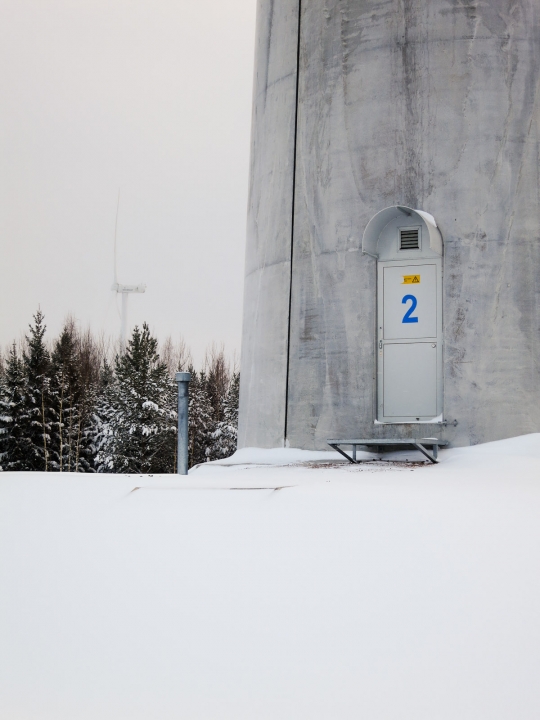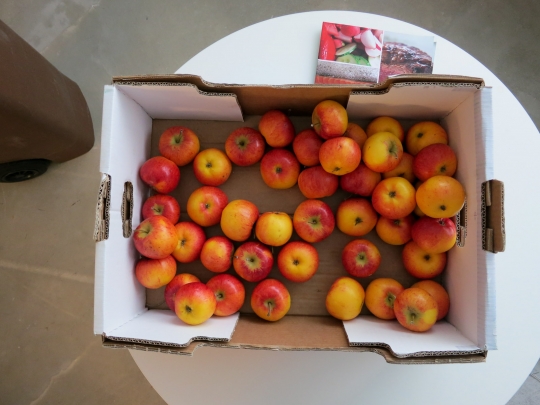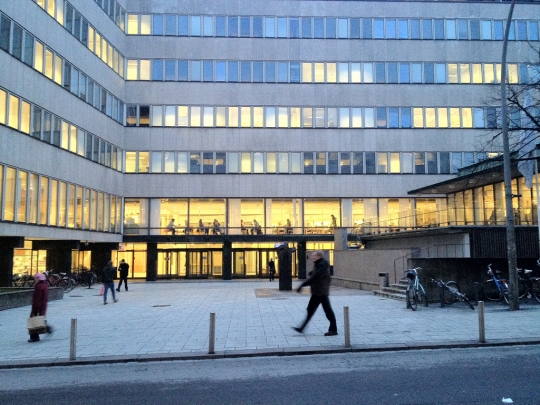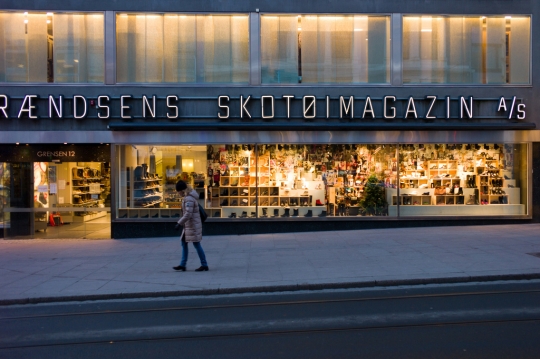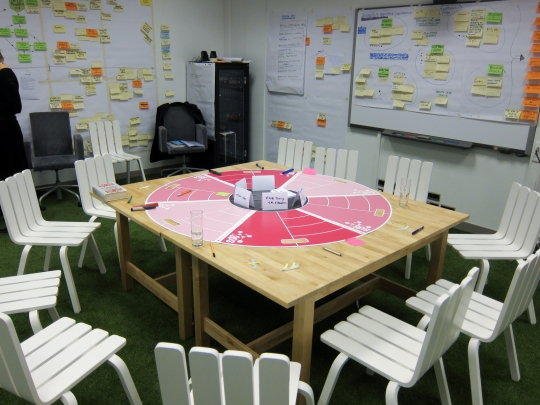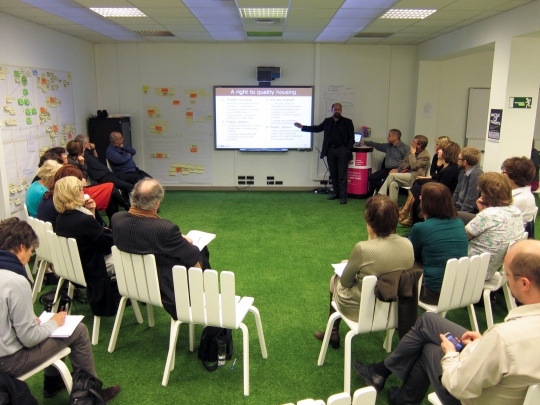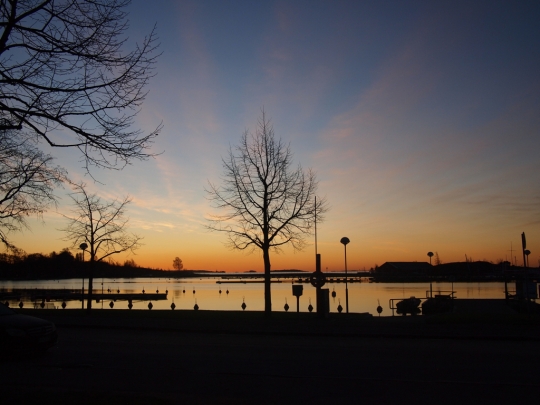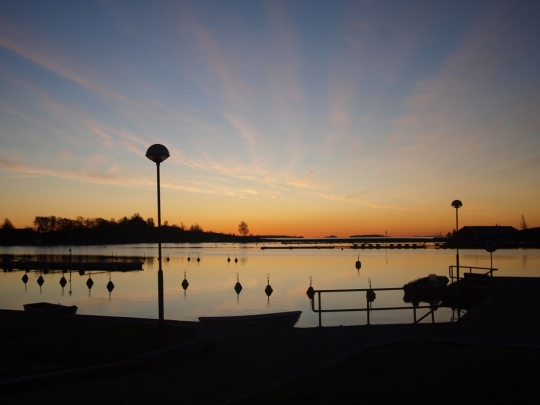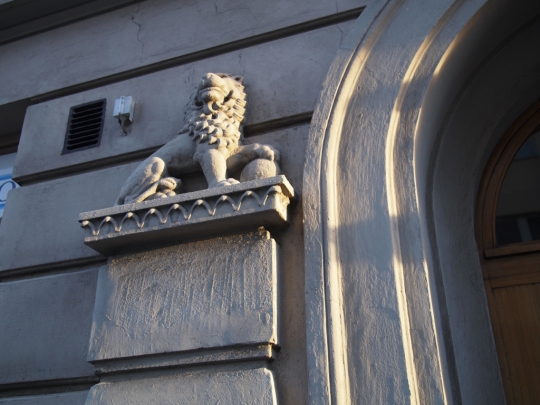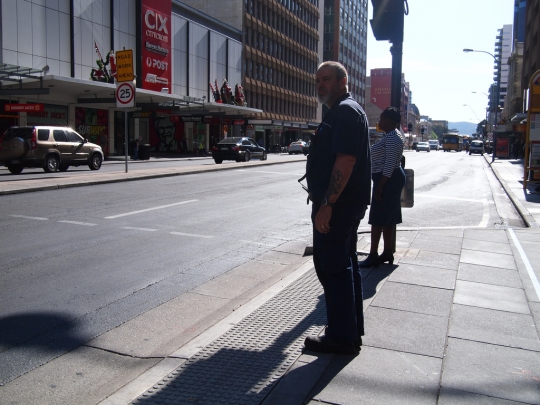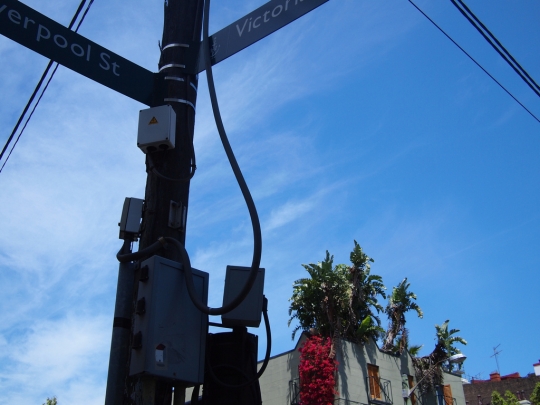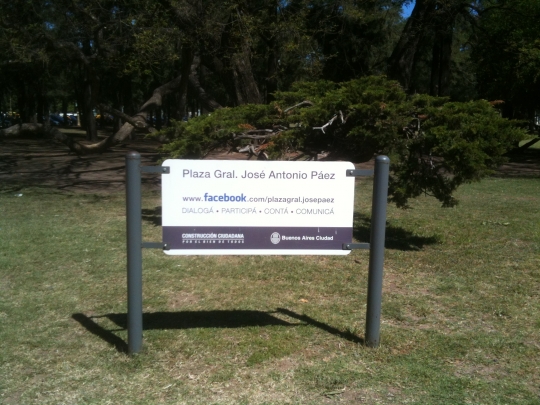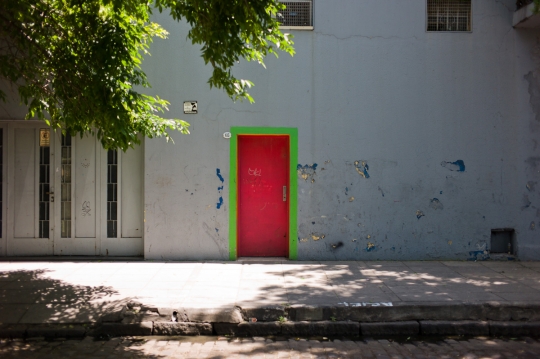Helsinki Design Lab helps government leaders see the "architecture of problems." We assist decision-makers to view challenges from a big-picture perspective, and provide guidance toward more complete solutions that consider all aspects of a problem. Our mission is to advance this way of working—we call it strategic design.
If you look very very closely at the photo above, you'll see a string of windmills on the horizon, set against the perfect blue sky. This is Högsåra, an island that forms a small part of the archipelago that stretches from Hanko to Turku in south-western Finland.
We're here to better understand the local decision-making cultures and stories - to explore how these wind turbines got up, including the resistance to them as well as those in favour. But our focus isn't wind power per se; we're looking at this case as it helps frame the wider debates about how to transition Finland to a more sustainable 'bio-economy', as our colleagues in Sitra's Maamerkit ('Landmarks') programme call it.
So we're interested in how communities might balance the desires of individuals with the desires of the wider community, the role of authorities and institutions as well as communities and industry, how we might reorient elements of bureaucracy such that they are more 'user-centred', how to use the powerful enablers of new communications platforms, alllied to the increased appetite for local engagement in decision-making, and so on.
We've also been to the port of Hamina in eastern Finland, towards the Russian border, as described by Bryan a couple of weeks ago. In both Hamina and around Högsåra, we interviewed several of the key protoganists in both stories. More to follow.
Our expedition team - currently Bryan, Karoliina Auvinen, and Nina the interpreter (who in Rosala was translating in three languages simultaneously: English, Swedish and Finnish!) - visited both places. As a side note, in a country as big as Finland and with a history as rich as Finland, it's fascinating for a mere immigrant like me to observe the differences between the Swedish-speaking western Finland as compared to the influence of Russia to the eastern side, and then with Helsinki, where we're based, caught in the middle. There are numerous cultures of decision-making at play here, even in a country of only 5.5m people.
Developments like wind farms, which can often be contentious for some, place these decision-making cultures under a microscope. But we'll also be roving around Finland a little, looking at other case studies, as well as exploring international examples of new kinds of decision-making that might enable more resilient economies - in the widest sense of the word 'economy'.
And then we will be building something, working with some local communities in Finland, perhaps prototyping a new kind of decision-making. Please do send us any examples you think might be relevant - it's a broad topic, so there is no chance we'll have all the right angles covered, particularly at this stage.
(From an organisational point-of-view - not that you need care! - it's also gratifying to see three Sitra teams (us at Strategic Design, Maamerkit and Energia) coming together for this project, as it helps flesh out how our new organisational model might work, with a new emphasis on doing projects, run by multi-facted project teams within broad and connected focus areas. It also builds on a long-term interest of mine in civic participation, which I summarised in this entry on 'emergent urbanism' a couple of years ago. My now colleague Bryan had, unbeknowst to me, started working on similar themes, building on the promise of Kickstarter. I would then build on this idea of 'a Kickstarter for development of shared spaces and resources', dubbing it Brickstarter, our informal working title for a while. Meanwhile, our colleagues in Maamerkit were also getting interested in terms of how to turn NIMBY into YIMBY, as regards bio-economy development. All these threads have now converged in this project. Funny how things work out.)
The other reason to mention Högsara - and Kasnäs and Rosala - is that it was startlingly beautiful. A simply stunning day, with endless blue sky over endless snow-covered frozen sea. Sadly, the Baltic is now so polluted that the traditional trade of fishing is no longer tenable here (at a Mistra event in Sigtuna, I heard the director of the European Environment Agency clearly outlined it was a matter of 'when' not 'if' the Baltic will collapse.) So, as beautiful as the area still is, the place needs to find new opportunities for locals. It's hard to credit when you're faced with these pristine images, which hardly do justice to the scene, but there are significant challenges facing these small dispersed communities, amidst the other 190,000 islands around the coast of Finland. Another reason why this project is fascinating.
In other news, the 'Helsinki Street Eats' book nears completion - yet again! But we're close now. And our discussions with the City of Helsinki over street food are getting interesting. It looks like this NIMBY>YIMBY project above will be joined by work in food entrepreurship as major new projects this year, alongside the existing Design Exchange, Low2No and Helsinki Design Lab.
And just on Design Exchange, Sara Ikävalo, the designer that we've worked with City of Lahti to 'place' into a forthcoming urban development project, joined Marco and I for a good planning session on Monday. She's hit the ground running and we're working on getting a blog together for that project too - there's already plenty to report. I'll skip the details for now, but - quietly and steadily - Design Exchange is one of our most radical projects in a way; placing strategic designers at the heart of government. A real test! More to follow, though, as Sara is already making a difference.
A good, productive week.
The week we're about to write into the archives here was the bridge between January and February. So it was a while ago, but since it's Week 150 (!) and technically still about the first month of the year, I thought I would share a bit of our trajectory for 2012.
From time to time we have strategy days. We tend to do it once every 6-8 weeks and these days involve the team secluding ourselves outside of the office in a cafe or restaurant for extended review of all of the ongoing work, any upcoming possibilities, and the various loose ends.
It feels like a nice rigor: meet 1st thing in the morning, make a long list, sort it until the easy stuff is at the top and the important-but-nebulous stuff at the bottom, and start discussing items off one by one. Refill coffees when needed.
The core of the conversation was on the portfolio of ongoing projects. It looks something like this:
- Low2No: continues apace. We're in the thick of it now with intricate negotiations tied to our investment relationship between Sitra and our two development partners. This project is about developing and demonstrating the efficacy of a model for low carbon urban development.
- Design Exchange Programme: The first placement has started already. We're negotiating the next 1-2 placements and hope to announce them soon. This project is about testing the (hopefully positive) impacts of having designers sit within municipal and ministerial project teams to connect strategy to implementation through design methods and approaches.
- Helsinki Street Eats: we're basically done with a publication and doing final due diligence on image rights and things. In parallel we're getting to know the key actors in Helsinki around street food. This project is about catalyzing some of the recent organic developments in food culture into a way to open new opportunities in policy and business.
- Brickstarter: research is well underway and we're starting to get lost—in a good way. This project is about developing new ways for communities to make shared decisions that take into account shared values.
- Sitra internal development: Sitra is currently reflecting on the way that we pursue our mission of making Finland a leader in sustainable wellbeing and we're playing an active role in these workstreams.
This on its own feels like an ambitious lineup for 2012. But there's one thing which is conspicuously missing: HDL Global. Two years ago we culminated the activity of 2010 including three studios and three case studies by inviting a group of incredible people to reflect upon and speculate about the role of design within government. Two years on and it feels like there may be another useful check-in point. But we're cautious.
One of the core principles of HDL Global 2010, like HDL 1968 in fact, is that we felt it important to bring some new knowledge to the discussion. That's why we did the studios and case studies first. Too often gatherings and conferences end up being a bunch of people in the same place at the same time. Don't get me wrong, there's a lot of value in this, as simple as it can be, but conferences for their own sake are rarely transformative and often exhausting. When making a soup first you have to boil a stock, you know?
Our caution about HDL Global 2012 stems from the fact that our work is at a fragile stage right now: will it be ready to share in a meaningful way by the end of the year? Low2No is producing very important learnings, but some of it is still hard to share openly; the Design Exchange Programme is just off the ground; and Food and Brickstarter are only now revving their engines so to speak.
My suspicion is yes, we will have insights to share in 2012, but we're waiting a bit longer before making a final go/no-go call. The topics of the moment in our team are the cultures of decision making and an interest in coherence. These would be the themes of HDL Global 2012 if we had to choose right now.
The former has been simmering for years, but developed to a new level of articulation during a coffee conversation that Dan and I had last spring. We were speculating about why some people are more naturally able to see opportunities for change and others are more tied to the status quo. My proposition was (still is!) that people who have experience with making things are more aware of and better informed about the choices involved in making that thing, and therefore better able to see the degrees of freedom. To see where a different course of action could be taken, perhaps even desire it.
The process of making a soup, for instance, helps give you insight into ingredients, first of all. But also the proportions between the ingredients and the sequencing and techniques of their handling. The first few times one makes a particular soup they may follow the recipe strictly, but an experienced chef is able to move away from the recipe and work on the principles underneath them. What starts out as a singular choice—to soup, or not to soup—devolves into many, many more discrete questions about all the nuances of the dish.
This applies to car engines, train schedules, literature, and legal documents as much as it does to soup. The more you know a thing, the better you see the landscape of possibility and, I would argue, the better you are equipped to question it.
When we talk about cultures of decision making, we're interested in the ability of individuals to see this landscape of choices, as well as their ability to navigate that landscape to consider alternatives, and what factors they use to evaluate alternatives and make a decision. In a way, we're pursuing a behavioral economics of the creative act, or a future studies of the present. These fields are stirring in our heads and reading lists along with neuroscience, psychology, and ethics.
In our various projects we're working towards something along the lines of a comparative study of cultures of decision making. When we work with the city on food regulations or talk to a community about how they decided to build a wind farm we're not interested so much in food or green energy, per se. Rather, it's the ways that they succeeded or struggled to make coherent decisions… which you might remember as the second bubbling theme of interest lately.
I think it was Marco who first articulated that "design is ultimately about bringing coherence" to a situation or thing. This feels like a useful evolution of the phrase that we've previously used to describe strategic design. We usually talk about strategic design bringing the same craft and care to decisions as traditional designers give to objects. "Coherence" is nice because it describes something specific and it also works well for both traditional and strategic definitions of design activity.
As we look at and explore these various cultures of decision making one of the things we're deciphering is how they construct and act on notions of coherence. What looks coherent to one person or community my not be so for another. It's a fascinating way to crack open a discussion. Or at least we're having fun with it, but maybe that's because we're all pretty nerdy for this stuff when you get right down to it.
What's on the top of your mind these days?
Three polite words that begin with F: frozen (temperatures), and freedom (from fossil fuels), and food. Let's see how these unpack.
Now that winter has set in, we are regularly experiencing temperatures in the range of -10º celsius. This makes for treacherous sidewalks but otherwise adds lots to the quality of life in the city: cross country skiing, sledding, new things on the ice, and plenty of light reflecting off the snow.
Recently Dan, our colleague Karoliina, Nina the intrepid interpreter, and myself spent a day in Hamina where it was also very frozen. Located 1.5 hours east of Helsinki, Hamina used to have two industries: a port and the paper mill but the later closed down in 2008.
Luckily for them, the mill premises found a new tenant who values cheap energy and the location's essentially limitless supply of cool Baltic water: Google purchased the property in 2009 and set up a data centre shortly thereafter.
Although the Google story is interesting, it's not the core of why we went to Hamina. We were there to learn about the way that the city has successfully fostered green energy, both as an energy source and as an industry. Early indicators point to Hamina as a positive example of how a community de-industralizes itself with as little long-term pain as possible. They paid attention to larger structural changes in Finland's economy and reacted decisively to find a new way forward. Google's data centre was one positive outcome, and the other is WinWind who manufacture wind turbines. In parallel with these new developments in the local economy, Hamina's municipally owned energy company also courageously set up a modest wind farm.
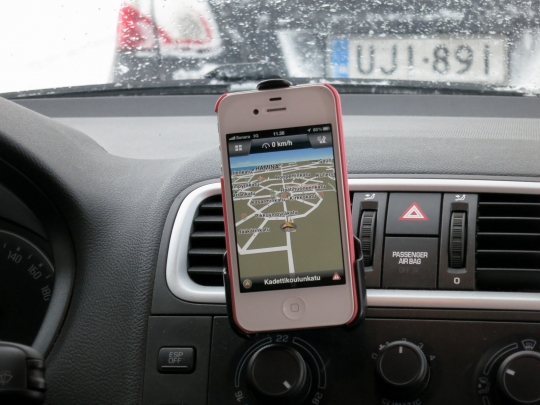
Hamina is known for having a circular town center
We wanted to understand how this happened. How does a community make decisions about its future? Or in other terms: how do communities make shared decisions from a shared value perspective?
Shared decisions are those which are bigger than any one person. Things like building a new road or rail, cordoning off a nature reserve, or passing a law. And shared value is measured in financial as well as social and ecological capital. Although the term is borrowed most recently from Michael Porter, the basic concept is by now quite generic—you might even argue that figuring out shared value is the challenge which underlays all others.
Our trip to Hamina was the first bit of research into this. How did they get the idea to build a wind farm? And how did it get negotiated in real space, with real euros, real local politics, and real personal opinions? How did Hamina decide to open its port area to new industries? How did Hamina propose for itself a new future?
In the coming weeks and months we'll be visiting other communities that have made—or failed to make—shared decisions as we try to better understand how we might help these processes flow more easily and productively.
One of the areas of focus is a phenomena called Not In My Back Yard (NIMBY) and how we might crack open more opportunity for Please In My Back Yard. In essence, we're interested in how communities balance the right to express negative opinions with the civic obligation of participation in the public realm, in local economies, in politics, in society. So how do we make it more meaningful and easier for people to engage in shared decisions? That's what we'll be focusing on in the area of work we've been calling Brickstarter internally.
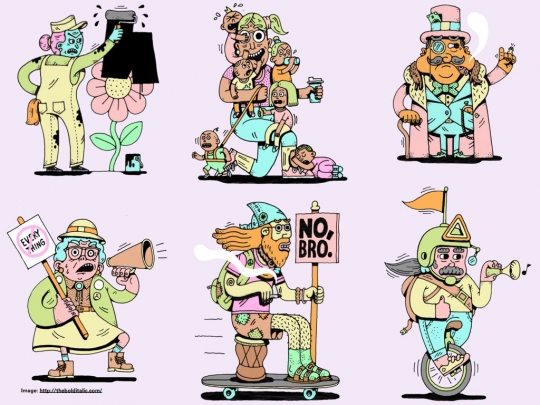
A collection of NIMBY archetypes by Miquel Hudin drawn by Loren Purcell
Justin, Marco, and Johanna spent most of Friday in Lahti working with the city planning department there as part of our Design Exchange Programme. Things there are off to a good start with an ambitious timeline. We are also working on a new website for the exhange participants to share their experiences regularly.
Internally at Sitra we continue apace with work on tools, systems, working culture, and spatial resources. The first three involve lots of meetings in conference rooms, the latter involved one meeting in a design studio. It's also worth noting that there's a new Sitra.fi website!
Dan was over in London this weekend giving a presentation at The Design of Understanding. It's a safe bet that you can expect a write-up of some 10,000± words from him in the nearish future.
As always, an update on the food work. We spent a bit of time in Tukkutori with Elina and Ville, sharing notes on what we're up to and the same from them. Tukkutori is Helsinki's wholesale market and will be opening to consumers in the fall. Lots of exciting stuff planned there and we're seeing how we might be invovled, particularly with an eye towards strengthening the pathways for good ideas to grow up to be good businesses and good regulations and policy.

You never know what you're going to find in Tukkutori
And yes, some mockups for print. The food booklet we're working on may or may not come with a poster.
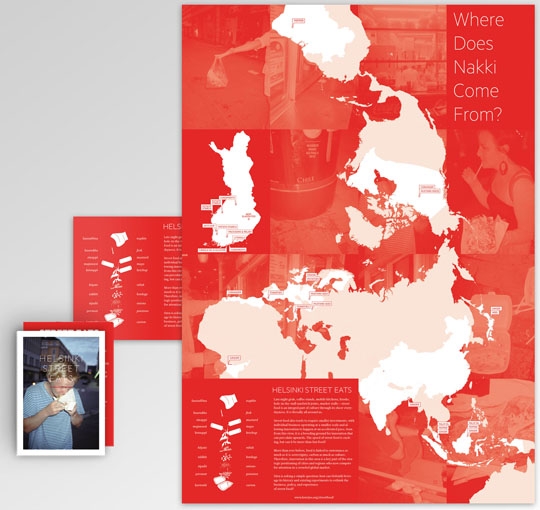
And... decloak!
Hi, we're back. Closing out all of the work and accounts before the end of the year became more hectic than any of us expected and that means we ended up with nothing more than crickets on this blog.
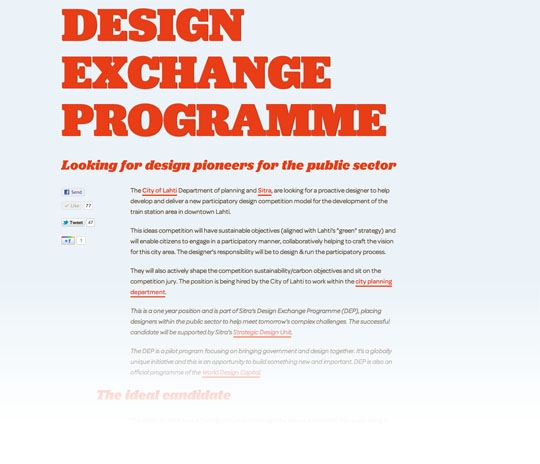
The Design Exchange Programme was announced in December and is now off to a promising start
In the interim, perhaps the biggest news is that we launched a new project called the Design Exchange Programme. At the moment it's a small and modest with just one placement. We'll have a full introduction to the chosen candidate in due time, but for now we would like to congratulate Sara Ikävalo on her successful application and thank her for taking this leap with us. We look forward to beginning in earnest in February.
Sara was the winning candidate out of a pool of nine applicates, four of which we had interviews with just before the holidays. With our Lahti placement now specified, we're beginning to look at the second partnership with another government body here in Finland. Updates when we can share them.
Otherwise: much of the same here. Dan and I are continuining to crunch on the street food booklet which we are now a bit late one. We're learning the hard way what it's like to bite off more than you can chew. Then again, the up side of never promosing a specific delivery date is that you're never late. But all jokes aside, we do hope to have a draft available for download imminently. At the moment we're doing the dilligence of clearing publication rights for archival images and other fun feats of legal maneuvering.
We have also been doing quite a lot of internal 'consulting' work on two fronts. First and foremost to work through our in-house strategy for internationalization, an update to our shared ways of working, and this inevitably means also looking at internal culture. These are mostly about behaviors and practices, but are always bound up in the artefacts and tools as well. So we find ourselves sketching out new document types, interfaces, and other bits of the internal Sitra workflow. We're interested in moving these into paper prototyping at some point, and then hopefully further into light weight software prototyping.
Marco and Justin are busy as ever with Low2No. Marco has also been spending time lately in discussions about potential upcoming work. Since we're not a commercial firm we don't have business development, per se, but we still spend a fairly good chunk of time exploring opportunities with a variety of potential partners to make sure that the projects we take part in are ones where we feel we have something useful to contribute.
And to close I'll leave you with nearly identical snapshots from two Nordic capitals near the end of the year:
The 'Exchange' project we've been referring to for a few months emerges a little, blinking in the shallow light of a cold December morning. We're looking for a strategic designer, with particular experience of urban and participatory design processes, to help design a new participatory design competition model for the development of the train station area in downtown Lahti.
It could be you! If you have a combination of excellent Finnish and some experience of architecture/urban planning, participatory processes and ideas competitions that is.
Bryan built a page at where you can find out more details and how to apply.
(This is a direct test of our notion that embedding a strategic design capacity at the heart of organisations makes the difference. It's a joint project with TEM, World Design Capital Helsinki, and City of Lahti, and hopefully the first of several similar experiments.)
Secondly, the City of Helsinki's Food Culture Strategy project manager, Ville Relander, dropped me a line about the former slaughterhouse building project he's been working on (an incredible space seen here back in June).
The first spaces in these premises are now becoming available for rent and Ville, and the City, are looking for "gastropreneurs" to apply - more info here. (The site's only in Finnish at the moment, so if you're not a Finnish speaker, get into Google Translate and see what you can do. Alternatively, get in touch with Ville directly - he'd be happy to answer any questions.)
Ville's showing people around the space tomorrow (Friday) 9th December at 1300 and again on Wednesday January 11th at 0900. Again, do get in touch with him directly to find out more (contact details at the bottom of this page or try Facebook, LinkedIn etc.).
First dusting of snow this week. Exciting!
As I write this post there's a bubbling hive of activity behind me inside the Flanders District of Creativity in Leuven, Belgium. I've come to sit in the back of the room while the government of Flanders hosts a studio on child poverty. But more on that soon. This is the culmination of a particularly hectic week with two book launches in the US, some fast-paced work on a handful of projects in Helsinki, and now Belgium.
Let's start in New York. Justin, Marco and I were pleased to host a launch party for In Studio with Amb. Ritva Jolkkonen, currently the Consul General of Finland in New York. She very kindly welcomed a group of designers, NGOs, and public sector people for a gathering at her residence which features a rather stunning view over central park. Naturally, this is the one time (seemingly) when I did not have a camera on me. You will have to imagine the view.
On Tuesday Marco spent the morning presenting at and moderating a discussion for an event hosted by MIT's Collaborative Initiatives. I wasn't in the room, but from what I hear he did a bang-up job keeping a group of big-wigs on track.
Just to make sure we're not being lazy, we also hosted a book launch in Cambridge, MA that evening, seeing as we were already in the neighborhood. Turnout there was good and it was nice to see some familiar faces.
Back in Helsinki, I had a brief meeting with the Helsinki Ympäristökeskus (Environment Center) relating to our ongoing street food work and Dan and I had the pleasure of meeting Stuart MacDonald. Stuart was in town from Glasgow for an event hosted by the British Council. He alerted us to some of the strategic design work that is bubbling up in the UK, particularly around community planning. We'll be digging into that more in the future as Brickstarter ramps up.
Oh right, Brickstarter is ramping up.
Speaking of the UK, Dan was in London for something less than 24 hours to participate in a meeting of the minds that attempted to merge neuroscience with... urban planning!
Amidst all of this Aalto University reversed an earlier decision about the name of the school which contains the departments of art, design, and architecture. Previously they had announced that it would be called the School of Arts and Creativity, but after significant public uproar it will now be called the School of Art, Design, and Architecture. Personally I see this as very positive. Claiming 'creativity' as a namesake was not only a little greedy, but also rather devaluing of the disciplines that the school represents.
The studio here in Leuven is getting ready to make their final presentation so I will hastily close this weeknote and leave the details of what's happening here for the next post.
This was the view in Helsinki (Eira, specifically) this morning as I dropped my kids off at päiväkoti (daycare). For a relatively new Helsinki resident, the sun appears to be doing some extraordinary things - hanging low in the sky for a few hours, and so bouncing off the Baltic at oblique angles and shrouding only the skyline of the city in a canopy of sunlight that just floats at the top of buildings. November, which roughly translates in Finnish to “dead month” I believe, is traditionally the grottiest month, all rain, cold and darkness before the snow comes to bounce the light around more. But so far it's relatively benign, almost mild. Almost.
Anyway, last week was spent picking up the pieces after the aforementioned Australia trip. I was able to spend a little time with Marco, who was largely knee-deep in stewarding Low2No and Exchange towards the end-of-year finishing line, trying to keep intent intact in both.
Justin and Bryan were in the USA, working on the NYC and Boston book launches for In Studio (both of which have now occurred, and went well by all accounts). Bryan and I managed to catch up about our work reshapng our office space and culture, with Tapio. We’re trying to prototype a new organisation, in line with our new strategy processes with Paula + team, through prototyping new approaches to spaces and systems.
I spent some time on this, and some time on Low2No also, eating up a forthcoming workshop with Arup, Experientia and Granlund, hoping to take the vision down a notch towards strategy; or really, a set of projects which exemplify and unpack the strategy.
Also, much writing. Not least for an upcoming shortish book on strategic design, picking up some of the leads from In Studio; it will include a short diatribe on why I think design thinking is largely a dead-end (before you send me hate-mail, please note the active modifier “largely”.)
I was also lucky enough to receive a visit from Seoul’s Hope Institute, who are perhaps the premier social innovation outfit in South Korea. As usual with these social innovation types (see last week) lots of overlap in terms of intent and approach. Thanks to Sunkyung and Yang So for swinging by on the way home. (Finnair’s strategy of making Helsinki the best European hub for Asia can really work in favour sometimes.)
Nice also to see Patricia McCarney, from the Global City Indicators facility, a colleague from the HDL Sustainability studio team, who was also in town briefly as part of a panel for an architectural competition.
I also had a coffee with the intriguingly anonymous blogger behind Jees Helsinki Jees, one of the best Helsinki0based blogs in terms of unpicking and critiquing the way the city is working. Or not. Sharp, acerbic and informed, it's good to see this kind of contribution to the conversation in a culture which can tend to shy away from uncomfortable topics. Her posts on parking regulations are worth the (free) price of admission alone.
And last but far from least, a really good meeting with the City of Helsinki, of which more later hopefully.
Finally, a new project from one of the world’s most interesting design firms (disclaimer: also good friends) BERG London, which subtly, wittily, playfully, respectfully and just plain smartly connects digital stuff to everyday physical contexts, habits and experiences in a way that has previously been beyond, well, most. Welcome, Little Printer.
Late late late, always with the weeknotes. I do apologise, not least to my more productive colleague Bryan, who is always on time with his weeknotes DAMN HIM. Bryan, Justin and Marco spent most of the week on Low2No here in Helsinki, while also setting up the forthcoming New York and Boston book launches for our In Studio: Recipes for Systemic Change book.
As for me and my tardiness, I can only point to the impact of a 4.5-day trip to Australia. I'm a member of the South Australian government's Integrated Design Commission Advisory Board, and we were due a meeting. As that's a long way to go for a meeting, every other minute was accounted for with some form of productive activity, save a jetlagged dawdle around Darlinghurst which I mentioned here.
The advisory board is good: it also features John Denton of Denton Corker Marshall (non-Australian readers may know their multiple-award-winning Manchester Civil Justice Centre building or their work at Stonehenge), plus the writer/critic Elizabeth Farrelly, who I'd long wanted to meet, as well as Dr. Graham Hugo, Prof. Catherin Bull, Prof. Janice Birkeland, Assoc. Prof. Joanne Cys and Jim Hallion from SA Dept. of Premier and Cabinet.
We have a good session in the morning discussing progress on strategic campaigns like Adelaide's 5000+ urban renewal/city redesign project, and how to link, say, a particular riverbank project to wider strategic change that might stretch right across South Australia (I'm always looking for Trojan Horses!)
In the afternoon we visit two local productive centres—Adelaide College of the Arts and The Jam Factory. Hearing the staff talk was fairly inspirational, as was seeing the students, craftspeople and artists at work. The live glassblowing at the Jam Factory was quite a blast, though it did occur to me that the heat outside on the street was approaching that of the kiln inside. Quite different to the Helsinki I'd left a few days before (although I'd seen similar scenes in a lovely archive documentary piece about the great Finnish designer Kaj Franck at an exhibition at our Designmuseo a few months ago.)
The work that Integrated Design Commissioner Tim Horton, and State Government Architect Ben Hewett, are doing in South Australia is really interesting. They're closer to government than us i.e. actually embedded within the core of Dept. of Premier and Cabinet, but it's one of the few other projects we know of worldwide beginning to build a strategic design capacity at the core of government. Thanks to Tim, Ben, Sky, and the rest of the team for a good couple of days.
I was also hosted by the Australian Centre for Social Innovation (TACSI) and much thanks to them as well, especially Sarah Stokely and Brenton Caffin. I had a good private session with them, also in Adelaide, and their projects—especially Radical Redesign and Family-by-Family—are well worth checking out. Again, fantastic work.
TACSI also co-hosted a public lecture I gave in Adelaide with the IDC, as well as a 'Social Innovation Dialogue' seminar I ran in Sydney (this was also a joint effort with Australian Social Innovation Exchange, whose Steve Lawrence came through Helsinki a few weeks ago, and was moderated by the great Martin Stewart-Weeks.) (Thanks to Alex Roberts at the Australian Government's Public Sector Innovation site for a nice write-up).
All that plus an interview on Radio Adelaide's show The Plan, with Angelique Edmonds (it's the South Australian version of Melbourne's essentially peerless 'The Architects', on Triple R) and a newspaper interview too. Phew.
Back in Sydney at the end of the week, I caught up with Gerard Reinmuth, a principal at one of Australia's most interesting architects' practices, Terroir (based simultaneously in Sydney and Copenhagen, as well as on the twitters.) Gerard is also Practice Professor on the Architecture at University Technology, and so I spent a enjoyable if challenging last day in Australia as part of a panel reviewing work on the course Gerard has been teaching over the last few months (panel also included John Choi from Choi Rophia and David Neustein of various. Strategic issues were also to the fore here, as the project was a Sydney-based detention centre for immigrants (talk about a loaded topic); but also much discussion of the particular qualities of building and site. Another excellent project.
So that was week 139 that was.
Roll call! Johanna is mostly pitching in on Synergize Finland projects, Justin is holding down the fort in Boston, Marco is in Moscow giving a talk at Skolkovo, and Dan is somewhere in Australia running at a breakneck pace with a full slate of talks, workshops, and meetings there. For more on that, follow Dan's Twitter account or look for the mentions of @HDL2010. And this leaves me, alone in Helsinki, spending the day out and about and writing.
Between bouts of project planning and other exciting administrative duties we've been continuing to drive our research into the street food of Helsinki. Below is a snippet of that, one of four narratives that we open the booklet with. They're meant to give snapshots of different key moments in the development of Helsinki's food culture. As you might guess, we're much more interested in the stuff around the food than the victuals themselves.
Ullanlinna, 1960
The woman shifts nervously from foot to foot outside the restaurant’s doorway. Above her, a green neon sign sputters into life, casting the restaurant’s name in flowing script across the elegant square, although the sun seems to have no intention of disappearing anytime soon. Still, it was late, and he was late.
She dares not go into the restaurant without him. This is not simply a matter of etiquette, or timidity on her part; it’s the law. In Finland, women are not allowed in restaurants unless accompanied by a man, so she waits. She finds this faintly offensive, as she’s heard that the reasoning is that women in a restaurant or bar on their own could only be there for one thing, and it wasn’t the food.
Dancing isn’t allowed either, for similar reasons; this she finds more ridiculous than offensive. There had been some progress, however: after the Helsinki Olympics, Alko, who set such rules, had deigned to allow the introduction of something equally licentious: the bar stool.
That the new owner of the restaurant is a woman, Mrs. Paukka, is an irony also not lost on her, but it makes no difference. For all her progressive attitudes, the woman had never been to a restaurant before, just as no-one in her family had. But she’d heard about Mrs. Paukka’s new menu—in particular the crispy fried Baltic herrings—and had pestered the man about going for weeks.
The sharp new kiosk across the square, owned by the restaurant and the only one in the country with an alcohol license, is full of men sitting, smoking, drinking, eating gelato, workers from banks and docks alike gathered around the small tables under the trees. She feels their eyes occasionally upon her. The woman pulls a copy of Kaunis Koti from her bag. She’d just bought the magazine from the R-Kioski on Korkeavuorenkatu, and had intended to save it for the tram ride home, but it would prove more useful as a screen to hide behind for the moment.
A skid of leather shoes on the cobbles behind her, accompanied by “Anteeksi, olen myöhässä!” …
Simultaneous to the writing, we're also doing some light data mining. I spent part of yesterday doing a bit of very light scripting to help us more easily pull data from the local restaurant website, Eat.fi. That process looks like this:

Left to right: 1) a map of open restaurants at a particular time, as provided by Eat.fi 2) the code on Eat.fi that makes this view possible 3) a small script that takes a bunch of copy/pasted HTML code and returns a count of the open restaurants 3) collecting that data by hand in Excel 4) visualizing it in Illustrator using a polar graph. Much faster than counting all of the dots on the map 24 times.
We wanted to make a simple point: at the moment when drinking activity on the typical weekend is spiking, food availability is crashing. Restaurants stop serving food and there is very little of a night time economy to speak of. So we made a diagram showing the opening hours of all 569 restaurants in central Helsinki. That's the red line of this diagram:
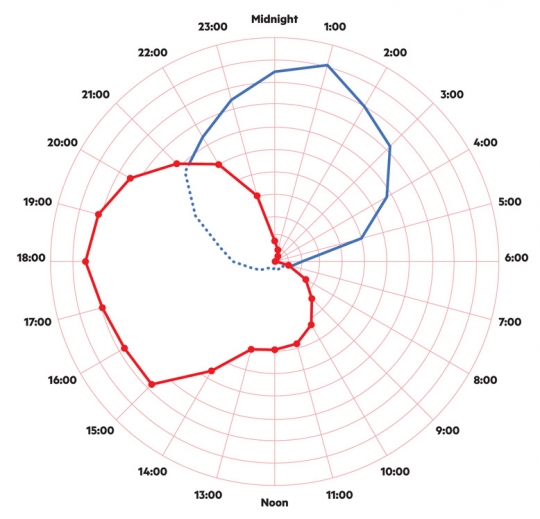
Red: # of open restaurants at each hour, as detailed in the records of Eat.fi (peaks at 422). Blue: anecdotal observation of public drunkeness (intensity & volume) on a typical Helsinki Friday
The blue line is interpretive, a sketch. It's not based on data at all. As we evolve this diagram we'll figure out a way to handle the discrepancy between these two (one based on data and one anecdotal observation) but for now it's shaping up as a way to illustrate the point. The fact that the red hoop and the blue hoop scarcely overlap is one (small) part of the reason why saturday morning the streets are dotted with puddled of vomit and why alcohol related injuries and assaults are high.
Of course this has a direct impact on the individuals whose health is impacted or who are the victims of violence or property damage. It also indirectly effects the efficacy of Helsinki's tourism strategy that seeks to make this a globally competitive destination. So here too the details matter.
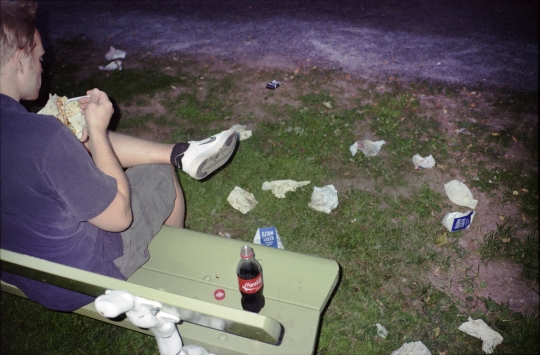
The primary offering today in Helsinki street food. Photo: Kaarle Hurtig for Sitra
As you can see, to make at point that sits at the intersection of governance, business, and culture we're starting to pull together a range of different sources as well. Mixing ephemeral narratives with the historical development of the market and its regulation from 1900 onwards; bits of data with rich imagery; interviews with close observations.
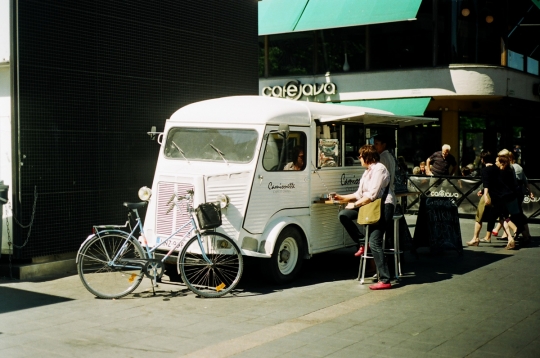
Mid afternoon coffee at Camionette
We've been moving between conversations and interviews with organizers and activitists like Olli Sirén, who has been the public face of Ravintolapäivä or Tio Tikka, who started Helsinki's only current food truck to The Public Works Department, who Dan and I visited this week.
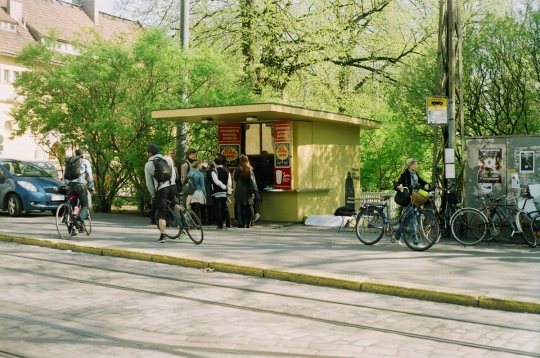
Snapshot from one of the restaurants open for the first Ravintolapäivä
In our booklet we're pulling together a bit of the history, current evidence, and indications of where there is untapped potential for innovation. Ultmately we are looking into the past before speculating about the next hundred years of everyday food in Helsinki and how we can make them even better. And in that regard we're focusing on how the dark matter, all the bits that situate food within our everyday lives—or not.
And to end, an observation about the color of milk packaging in northern Europe, provided by the ever amusing and insightful The Kaspar Stromman Design Blog.
First, a note from one of Sitra's other projects called Reviving Village Within A Town. In an effort to enable young people to have a more active role in co-designing the services that are available to them (like sports programmes), and therefore also getting more out of these services, we find two intertwined lessons. One about time and one about scale.
“People are active themselves instead of waiting for others to do things on their behalf. After all, local well-being is built on the people’s own initiative and activity,” [project manager] Mira Sillanpää points out. “You must also remember that it is not always about creating all-embracing solutions for the long term. Small changes can also have a huge impact. If the needs of the local residents change, the services provided by local authorities must change accordingly.”
In Mira's observations as quoted above, there are familiar tones of the ethos of prototyping, of beta, and of iteration. But perhaps more profound is what she gets to at the end: that times change, needs change, and that our public services should be similarly agile. In other words, being able to end programmes gracefully is as important as starting them intelligently.
And this ties to another aspect of the project which is embeded in the very name of the work: Reviving Village Within a Town. Lurking here is a recognition that scale matters too. The project is located in Hämeenlinna, a town that includes a number of smaller villages. By making room for local communities to conduct low-risk experiments in their own areas, we gain the ability to test and iterate at a more manageable scale before growing or replicating what works to other communities.
In other words, early innovations are not for everyone, and not for everywhere. Utilizing the small scale—in both time and space—allows us to be more sophisticated about our risk assessments. More of this please.
Twelve thousand kilometers away, in sunny Buenos Aires, the government there is also thinking about the power of the small scale, albeit in different ways. While in Argentina to give a talk as part of the CMD international design conference, I noticed that some of the parks have signs which implore residents to visit a Facebook page like this one. One finds a brief bit of history about the place, an invitation to share stories, participate in events, and to use the public space to organize your own functions. Smart, simple, cheap.
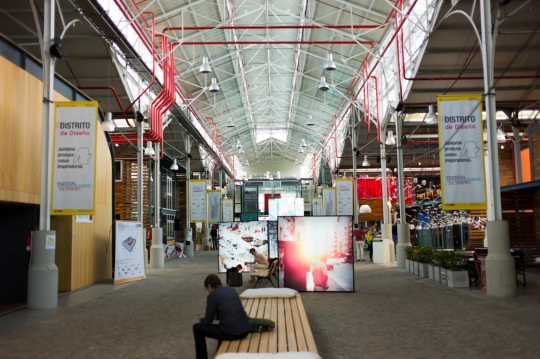
CMD is housed in a large building that used to be a fish market. It's vast!
But to CMD, the main point of the trip. The Centro Metropolitano de Diseño is a facility sponsored by the city government of Buenos Aires in an attempt to boost the creative industries. It's a bit similar to the the Design Forum here in Helsinki, except CMD also includes incubation space for young design-led companies. Under the ambitious leadership of Enrique Avogadro, CMD are expanding their focus to look at the potential for design-related business and programmes that are able to generate social capital in addition to financial capital. Being located next to one of Buenos Aires' villas provides extra imperative. This is the context in which I was there to share Sitra's work on strategic design, and particularly what it means to practice design in a public sector context.
Back here in Helsinki, as we continue to develop our work on the mysterious exchange project, we've been looking at things like this Bloomberg Innovation Delivery Fellowship. And then for no particular reason other than the fact that we saw it from a couple different people on twitter, also MIT's Atlas of Economic Complexity.
Dan spent a couple days in Sigtuna, Sweden where he was part of an international workshop hosted by MISTRA, The Foundation for Strategic Environmental Research, who are undertaking an ongoing indea development programme to identify new areas of research. After that he and I were consolidating thoughts on some small renovations to the Sitra tower.
Marco was in Finland but in and out of the office, including giving a talk at a Fortum event as well as taking part of the ongoing World Design Capital public sector working group.
Justin took a day trip from Boston down to New York to meet with the consulate there and begin preparations for an upcoming book launch later this month. He's also taking care of logistics for a launch in Boston, so if you're interested in either of these, check back in a week or so for further details.
And daylight savings time happened, so it's officially dark here. This was week 137.
